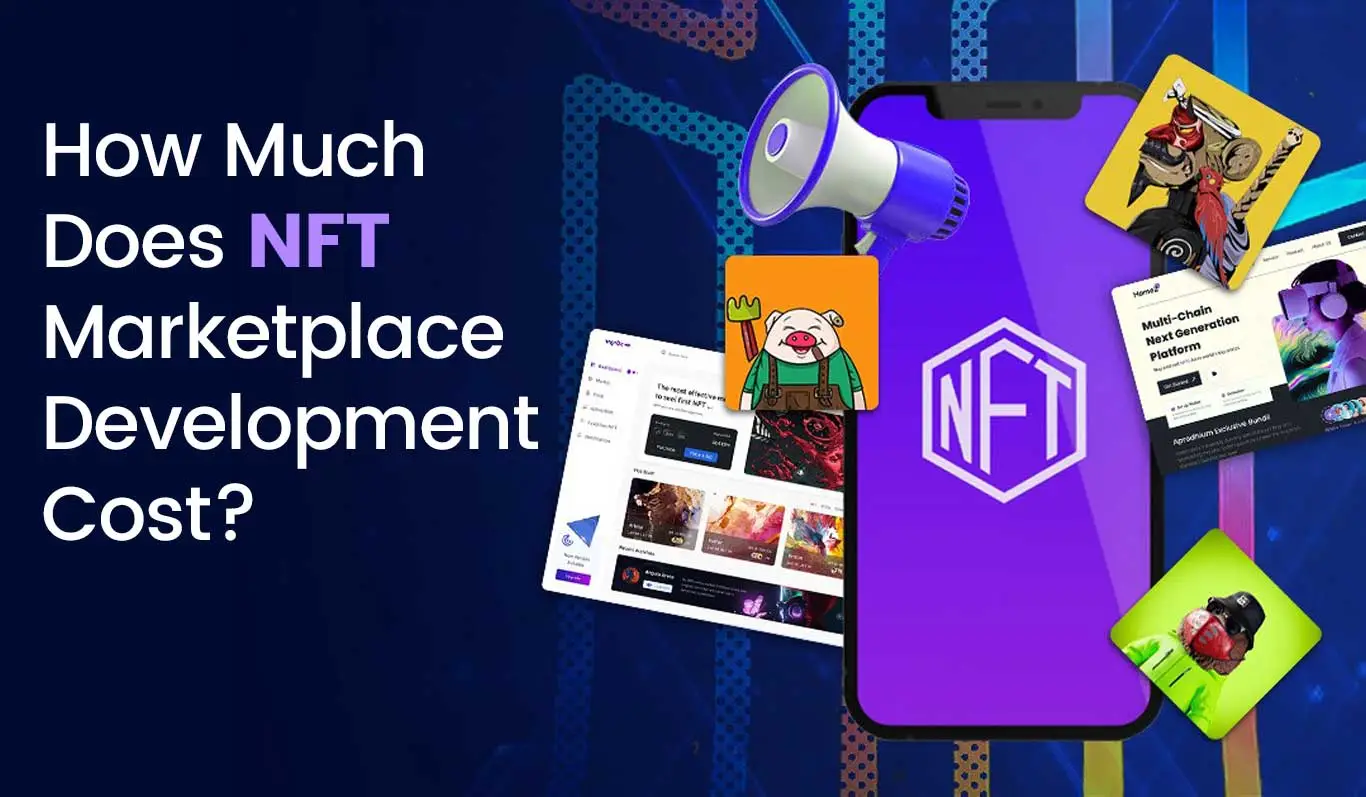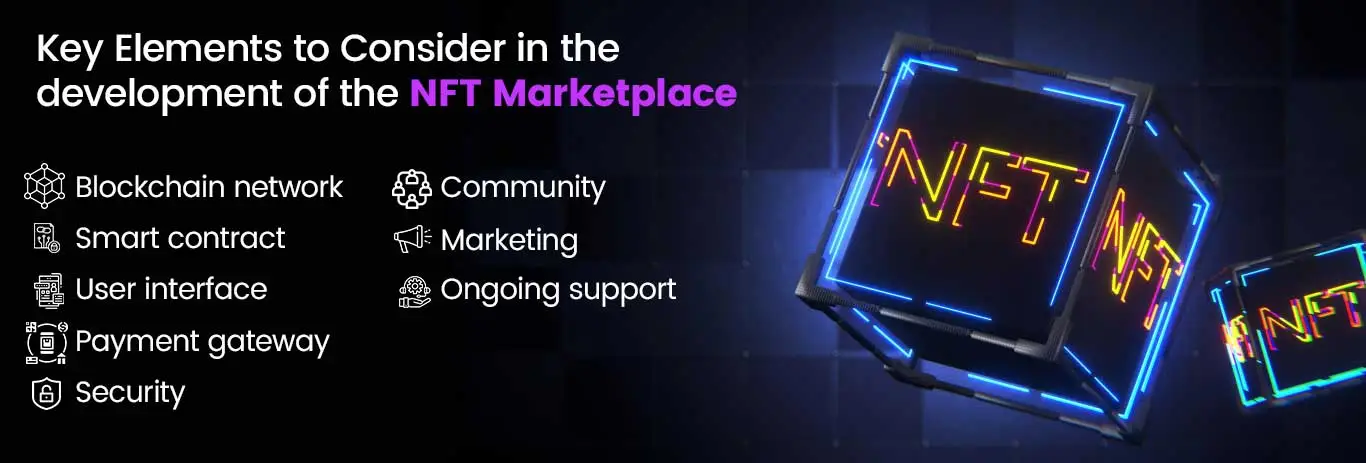How Much Does NFT Marketplace Development Cost?

The market valuation of all significant NFT technology projects increased by 2,200 percent in February 2021. This market increased by 400% in the previous year. Most NFTs are instantly sold out, and the most well-known NFTs are sold for $75 million. Celebrities that tokenize their artwork—such as paintings, music memes, short movies, meme logos, computer code, and more—are a major contributor to this.
The platforms that provide consumers the most straightforward and safe experience possible when purchasing or selling NFTs are the main purchasers of NFTs on the market.
What are NFTs?

Creators sell their non-fungible digital commodities in an NFT marketplace, and buyers pay for them with cryptocurrencies like Bitcoin or Ether. The market charges a transaction fee for each NFT that is purchased via a platform.
The buyer receives a token, a unique identifier that serves as evidence of ownership and contains information about the author, provenance, and authenticity, after paying for the NFT.
NFTs have gained popularity in the art world and have been used to sell digital artwork for millions of dollars, as they allow artists to prove ownership and authenticity of their work in a way that was previously not possible with digital art.
NFTs have also been criticized for their high energy consumption and for contributing to the ongoing environmental concerns associated with blockchain technology.
How do NFT markets operate?
NFT marketplaces are online platforms that allow creators to sell their unique digital assets to buyers who are interested in owning them. These marketplaces operate on blockchain networks, such as Ethereum, and use smart contracts to facilitate the buying and selling of NFTs.
Here's how NFT marketplaces typically work
Creators upload their digital assets to the marketplace, along with a description and a price they are willing to sell it for. Buyers browse through the marketplace and select the NFT they want to purchase. The buyer sends a transaction to the marketplace using a cryptocurrency such as Ether, which is then held in escrow by the smart contract.
Once the transaction is confirmed, the smart contract automatically transfers the ownership of the NFT to the buyer and releases the payment to the seller. The buyer can then view and manage their NFT in their digital wallet.
Some popular NFT marketplace development includes OpenSea, SuperRare, and Nifty Gateway. These marketplaces typically charge a fee for each transaction, which is usually a percentage of the sale price of the NFT.
An Overview of NFT Market Development
The development of the NFT metaverse marketplace can be traced back to the early days of blockchain technology, when developers were exploring new use cases beyond cryptocurrencies like Bitcoin. In 2012, the concept of "colored coins" was introduced, which involved assigning metadata to a Bitcoin transaction to represent a digital asset.
In 2015 Ethereum allowed developers to create smart contracts, which are self-executing contracts with the terms of the agreement between buyer and seller being directly written into lines of code. This enabled the NFT marketplace development, which could be used to represent ownership of a specific piece of digital content.
In 2017, Crypto Kitties, a blockchain-based game that allowed users to collect and breed virtual cats, became one of the first popular use cases for NFTs. The game's popularity caused congestion on the Ethereum network and highlighted some of the scalability issues of using a blockchain for digital asset ownership.
The NFT market has continued to grow and evolve, with new marketplaces and platforms emerging to support the buying and selling of unique digital assets. The art world has been particularly interested in NFTs, with several high-profile sales of digital art for millions of dollars.
The NFT development platform has also faced criticism for its environmental impact and the potential for fraud and exploitation. As with any emerging technology, the development of the NFT market is still ongoing, and its long-term impact remains to be seen.
Process of NFT Marketplace Development
The process of developing an NFT marketplace can be complex and time-consuming, but generally involves the following steps:
Define the project scope and requirements:
Determine the goals of the marketplace, identify the target audience, and create a list of features and functionalities that the marketplace will need to support.
Choose a blockchain network:
Select a blockchain network to build the marketplace on, such as Ethereum, and determine the necessary tools and frameworks to use.
Develop the smart contract:
Write and test the smart contract that will be used to create and manage the NFTs.
Design the user interface:
Develop a user-friendly interface for buyers and sellers to use, including features such as search, filtering, and sorting.
Implement payment gateway:
Integrate a payment gateway to enable transactions to be made using cryptocurrencies such as Ether.
Test the marketplace:
Test the marketplace thoroughly to ensure it is working correctly and meets all project requirements.
Launch the marketplace:
Once testing is complete, launch the marketplace and begin marketing it to potential users.
Provide ongoing support:
Provide ongoing support to users and continue to improve and update the marketplace based on user feedback.
It is worth noting that there are many pre-built platforms and frameworks available that can simplify the development of an NFT marketplace, allowing developers to focus on customization and branding rather than building the entire marketplace from scratch.
The development of an NFT marketplace involves several key elements that must be carefully considered to ensure the marketplace is functional, user-friendly, and secure.
Features to Consider in the development of the NFT Marketplace

Some of the key elements to consider in the development of an NFT marketplace include:
Blockchain network:
Choose a blockchain network that is suitable for the marketplace and its intended use case, taking into consideration factors such as scalability, transaction speed, and gas fees.
Smart contract:
Develop a robust smart contract that can handle the creation, transfer, and ownership of NFTs, and includes features such as royalties, bidding, and verification.
User interface:
Design a user-friendly interface that allows users to easily browse, search, and purchase NFTs, and includes features such as filtering, sorting, and categories.
Payment gateway:
Integrate a payment gateway that allows users to make payments using cryptocurrencies, and ensure the gateway is secure and reliable.
Security:
Implement strong security measures to protect the marketplace and user data, such as encryption, two-factor authentication, and regular security audits.
Community:
Build a strong community of users and creators around the marketplace, and provide features such as social media integration, ratings, and reviews.
Marketing:
Develop a marketing strategy to promote the marketplace and attract users and creators, including social media, content marketing, and paid advertising.
Ongoing support:
Provide ongoing support and updates to users and creators, including customer service, bug fixes, and feature enhancements.
By carefully considering these key elements, developers can create an NFT marketplace that is secure, user-friendly, and appealing to both buyers and creators.
How Much Does it cost to develop a NFT Marketplace
The cost of NFT marketplace development service can vary widely depending on various factors such as the project scope, the complexity of the features, the chosen blockchain network, and the development team's location and expertise.
However, some of the key cost factors to consider include:
Development team
The cost of hiring a development team or company to build the marketplace will depend on the size of the team, their level of expertise, and their location. Hiring a team in a high-cost region like the United States or Europe will be more expensive than hiring a team in a lower-cost region like India or Eastern Europe.
Blockchain network
The cost of building an NFT marketplace will depend on the chosen blockchain network, as different networks have different transaction fees, gas prices, and development costs. For example, building on the Ethereum network may be more expensive than building on a newer, less established network.
Smart contract development
The cost of developing the smart contract that will power the NFT marketplace will depend on its complexity and the level of customization required. A more complex smart contract with advanced features such as royalties and bidding will be more expensive than a simpler contract.
User interface design
The cost of designing a user-friendly and attractive interface for the NFT marketplace will depend on the level of customization required and the design team's location and expertise.
Legal and compliance
Depending on the marketplace's location and the regulations that apply, there may be legal and compliance costs to consider, such as obtaining licenses or registering with regulatory bodies.
The cost of developing an NFT marketplace can range from tens of thousands to hundreds of thousands of dollars or more, depending on the project's complexity and requirements. It is essential to work with an experienced development team and carefully consider all cost factors to ensure the project stays within budget.
Contacting one of the top blockchain app development companies is the next step.Neetable helps you create a custom NFT marketplace and convert your company idea into a reality that generates profits.
We are industry leaders because we invented NFT business models and marketplaces.
We can help you create NFTs that are exclusive to your brand and the market in order to expand your revenue model. We are here to help you turn it into a reality that is revenue-friendly when we build the NFT platform.
Request a Quote
Categories
Popular posts
Best Practices for Software Product Engineering Every CTO Should Implement
2023-14-18How to Build Your Own On-Demand Carpooling App Services?
2023-08-25How to Start an On-Demand Fuel Delivery Business: A Comprehensive Guide
2023-07-28Empowering Miners: How Fleet Management Apps are Transforming the Mining Industry?
2023-07-21A Complete Guide to Develop a Food Delivery App for Restaurants in 2023
2023-07-08Mobile Apps Transforming the Travel Industry: A Game-Changer in Travel Planning and Experience
2023-07-07
